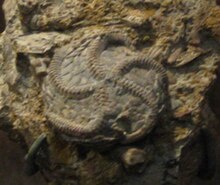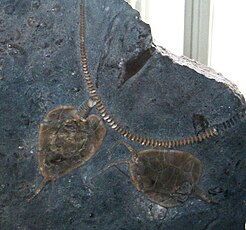Edrioasteroidea
| Edrioasteroids Temporal range:
Possible Ediacaran occurrence | |
|---|---|

| |
| Foerstediscus splendens | |
| Scientific classification | |
| Kingdom: | |
| Phylum: | |
| Class: | Edrioasteroidea
|
| Genera | |
|
See text | |
Edrioasteroidea is an extinct class of echinoderms that lived from the Ediacaran (if Arkarua was indeed an edrioasteroid) until the Permian, about 300 million years ago. The living animal would have resembled a pentamerously symmetrical disc or cushion.
The body plan for this class was simple: a main body (theca), composed of many small plates, a peripheral rim for attachment, and (in some species) a pedunculate zone for extension and retraction. Circling and sometimes attached to the body was a peripheral rim of plates. The main feature was five arms, or ambulacra, in the body wall radiating from the central mouth outwards. The ambulacra grew either curved or straight. When curved, they may all turn in the same direction or else one or two on the right side will curve opposite the others. The ambulacra are built of underlying floor plates that form the food groove and protective cover plates the roof the food groove. The anus was under the mouth region and was made of small triangular plates to form a cone-shaped area. The bottom surface of the theca is unplated.
Edrioasteroidea were obligate encrusters and attached themselves to inorganic or biologic hard substrates (frequently hardgrounds or brachiopods).[1]
Edrioasteroid species are distinguished by differences in the ambulacral curvature, the relationships of the cover plates, and ornamentation. The mode of life was sessile; they were often attached via a stalk made of small plates to a hard object such as a carbonate hardground or shell. Several examples of epibiotic attachment have also been noted.
In the discocystinids, the area between the body and peripheral rim could be extended and retracted; in so doing the two were separated. The peripheral rim became the base of the stalk which was attached to a surface. Underneath the body was a recumbent zone about 12 millimetres (0.47 in) wide in the genus Giganticlavus, followed by the pedunculate zone attached to the peripheral rim of 12 millimetres (0.47 in).[2]
Taxonomy
List of genera
A very incomplete list of some genera.
- ?Arkarua
- ?A. adami (may be a Trilobozoan with pentamerous symmetry, and not an echinoderm at all)
- Walcottidiscus (oldest undisputed edrioasteroid, from the Middle Cambrian Burgess Shale community)
- W. typicalus
- Kailidiscus
- K. chinensis
- Edrioaster (type genus)
- E. bigsbyi
- E. priscus
- Edriophus
- E. levis
- Paredriophus
- P. elongatus
- Totiglobus
- T. nimius
- T. lloydi
- Lebedodiscus
- Foerstediscus
- F. grandi
- F. splendens
- Cystaster
- C. stellatus
- Cryptogoleus
- C. chapmani
- Bellochthus
- Streptaster
- S. vorticellatus
- Cryptogoleus
- C. chapmani
- Carneyella
- C. pilea
- C. faberi
- C. ulrichi
- Isorophus
- I. cincinnatiensis
- Isorophusella
- Rectitriordo
- Agelacrinites
- Krama
- K. devonicum (Bassler), 1936
- Parakrama
- Hemicystites
- H. bohemica
- H. chapmani
- H. devonicus
- Neoisorophusella
- N. lanei
- N. berryi
- N. maslennikovi
- N. whitesidei
- Curvitriordo
- Thresherodiscus
- T. ramosa (Foerste, 1914)
- Postibulla
- P. westergaardi
- Parapostibulla
- P. belli
- P. graysoni
- Eopostibulla
- Pyrgopostibulla
- Torquerisediscus
- Cooperidiscus
- Dynocystis
- Stalticodiscus
- Ulrichidiscus
- Clavidiscus
- Discocystis
- Hypsiclavus
- Spiraclavus
- Giganticlavus
- Lispidecodus
- L. plinthotus (Kesling, 1967)
References
- ^ Streptaster vorticellatus
- ^ Sumrall 1996
All accessed on March 8, 2008.
- http://www.ucmp.berkeley.edu/echinodermata/edrioasteroidea.html University of California, Berkeley.
- http://drydredgers.org/edrio1.htm Compiled by Colin D. Sumrall.
- http://www.tulane.edu/~csumral/Abstract Spiraclavus nacoensis, a New Species of Clavate Agelacrinitid Edrioasteroid from Central Arizona by Colin D. Sumrall.
- http://www.science-art.com/image.asp?id=1357 Reconstruction by Emily Damstra.
- http://gsa.confex.com/gsa/2003AM/finalprogram/abstract_65113.htm Geological Society of America.
- http://www.tulane.edu/~csumral/morph.html by Colin D. Sumrall
Taxonomy
Gallery
-
Streptaster vorticellatus (13 mm across) from the Bellevue Formation (Upper Ordovician) at the Maysville West roadcut of northern Kentucky, USA
-
Edriophus pigsgi, Mid-Ordovician, Canada
-
The Upper Ordovician edrioasteroid Cystaster stellatus on a cobble from the Kope Formation in northern Kentucky. In the background is the cyclostome bryozoan



